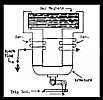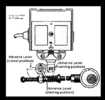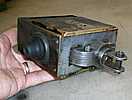Also see "Ed, the Oil Well Expert ;-)"
Shallow Oil Wells - Ferdig, Montana
1,300 feet deep is shallow in the oil businessThis field was marginal in the 1950s - just about depleted :-((
A good producing well pumped about 8 barrels of crude a day - about $3 per barrel :-((
At age 17, (probably physically and emotional age 15) I went to college at the University of Minnesota. I had no idea what I wanted to work at in my life - so I went into the college of "Science Literature & Arts", SLA for short.
Trying to figure life out, I took a wide sampling with no major, college algebra, calculus, geology, physics, chemistry, psychology, ... even one lecture of pre-med zoology (very serious !!, I left) (no art, music nor basket weaving ;-).
... and had worked as a janitor and cracker truck loader (teamster's union, Jimmy Hoffa was the new hope to stop the corruption ;-) to help with the money ...
After 4 years of hopeless drifting, I quit - what to do??
The Korean "police action" was raging and the college exemption was over - but I wasn't all that eager to get into the military -
The family had previously visited Cousin VeraLouise and husband Carl Jansky who had secured an oil "lease" just east of Ferdig, Montana. (A story in itself !!) A pleading letter went to them, could I visit them for some months and is there work available?
A letter came back saying
- a) Yes, there is a spare room to stay in
- b) I could be a "handy man"
at Ray German's machine shop in nearby "Four Corners", Montana.
I had acquired "a set of wheels" (a car) while in college, so packed up and headed from Minnesota to Montana.
About the oil technology of the area. Background, the oil was "shallow", 1300 feet down. The oil field was no longer the big producer of the 1920s and 30s but still worth pumping.
The oil technology, shallow wells (about 1,300 feet) 1920s technology (typical of Ferdig, Montana in 1950)
- Grossly stolen from
http://aoghs.org/technology/oil-well-pump/
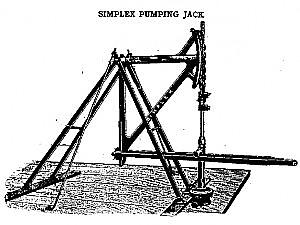 However, it was not long before a more compact and efficient mechanism replaced the multiple wooden Samson post and walking beam arrangement.
However, it was not long before a more compact and efficient mechanism replaced the multiple wooden Samson post and walking beam arrangement.
The 1913 Simplex Pumping Jack was a widely popular offering from Oil Well Supply Co. of Oil City, Pennsylvania. A central power source could connect and operate several of these dispersed Simplex units by way of steel rod lines (also called jerk-lines). Roger Riddle, a local resident and field guide for the Oil & Gas Museum in Parkersburg, West Virginia, was raised around central power units and the rhythmic clanking of rod lines. Today, Riddle guides visitors through the nearby woods where remnants of these elaborate oil well pump systems quietly rust. “They pumped with just these steel rods, just dangling through the woods,” says Riddle. “You could hear them banging along – it was really something to see those work. The cost of pumping wells was pretty cheap.”
Machinery at an oilfield “jack plant” included an engine — often a single-cylinder horizontal gas engine powered by natural gas from a nearby well — that rotated one eccentric wheel (wheel with the axle not in the center) that alternately pushed and pulled steel cables — known as jack-lines or jerk-lines) attached to pump jacks at oil wells. Steam power initially drove many of these eccentric power units, but some engines were converted to burn the natural gas or other inflammables often found with oil. oil well pump
Single-cylinder steam engines converted to gasoline power were called “half-breeds” and remained beloved among collectors of oilfield antiques. The conversions usually replaced the steam cylinder with a jacketed cylinder and piston assembly, keeping the original frame and flywheel. The new engine was half steam and half internal combustion, hence the name. Early internal combustion engines produced only a few horsepower and could not replace steam engines in most applications, but by 1890 they were powerful enough for most portable or remote operations.Electrification arrived and the heyday of central power units passed, but not entirely. |
Comments about the above descriptions: (usually comparing with 1950 Ferdig, Montana experience)
- The "Oil Well Supply Co." was still a big supplier in near Ferdig
- The sample engine in the pump house was "Franklin Valveless Gas Engine" implying
a 2 cycle ( or 2 stroke ) engine. All the engines near Ferdig were
4 cycle ( with an exhaust valve and usually an input valve ).
The most popular engine was "Superior" followed by "Fairbanks Morse". Carl Jansky had a "Bear" engine. - These engines were all
- Huge, pistons 10 inch diameter minimum, 12 inch average
- Slow, about one spark and power cycle per second, 120 RPM
- Electric spark ignited (see magneto below.)
- Usually powered by well gases
- Speed governed by
centrifugal flying balls,
too fast caused skip of ignition
"Hit & Miss" technique - Run 24/7 unless a problem, cylinder rebored to round about every 10 years.
- Almost everyone had a 5 hp gasoline engine with a temporary friction connection to
a flywheel to help start the main engine. Start the little engine,
press its power takeoff against the big flywheel to start the main engine moving.
(The EPA must have had a field day making new rules.) - There was some kind of clutch so the engine could be de-coupled from the load for starting and testing.
- The "Eccentric Power" in the above diagram must have a gear reduction system. (no way you can run that engine slow enough to do the usual say 8 second pull rod cycle. Faster than that you are going to break something "real soon now".)
- The "Eccentric Power" units near Ferdig were universally a large ( say 20 diameter ) wheel driven by the belt from the engine wrapped around most of it. This provided a low stress, reliable speed reduction/force_increase to match the engine RPM with the pull rod cycle speed.
- The pull rod supports were almost all "Friction-post support" type. Maybe every few months someone would slop say a half cup of crude oil on the wooden U member.
- Each engine_"Eccentric Power" would power 15 to 20 well jacks.
- The article mentions that electrification arrived, and it did at Ferdig. If an engine
had been re-bored so much that further was impractical, or other serious event,
or a new owner wanted to reduce labor cost or ..., a lease got converted to electric
Maintenance on a 101 Year Old Oil Well - Early on the electric motors and pump jacks would get synchronized, all would lift at the same time, causing heavy currents, low voltage cycles and blown circuit breakers. I forget what cute trick was used to prevent this effect.
|
All of the magnetos on this oil field seemed to be the non-rotating type.
They depended on having a stationary magnet and an iron magnetic path surrounded by lots of turns of fine wire. When you wanted a spark, you opened a gap in the iron magnetic path which greatly reduced the magnetism in the iron path. This caused a voltage in the turns of wire, enough to cause a hot spark in the spark plug in the engine.
The operation of the Wico unit is presented in the GasEngine Magazine. |
A web site of cable tool well drilling.

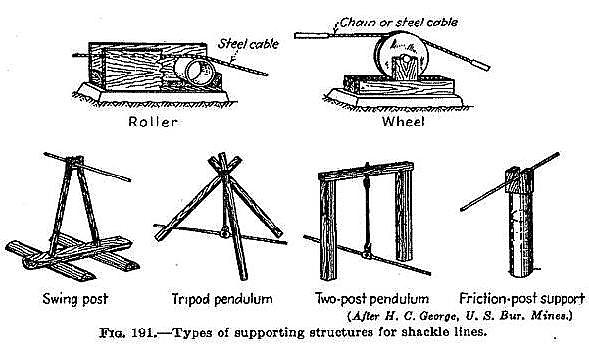 Examples of supports for jack-lines from the 1925 “Surface Machinery and Methods for Oil-Well Pumping” by H.C. George.
Examples of supports for jack-lines from the 1925 “Surface Machinery and Methods for Oil-Well Pumping” by H.C. George.
